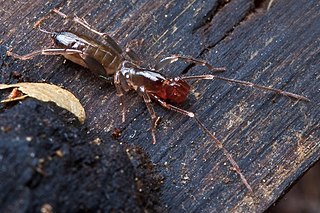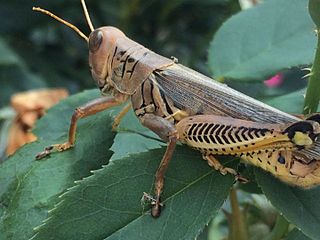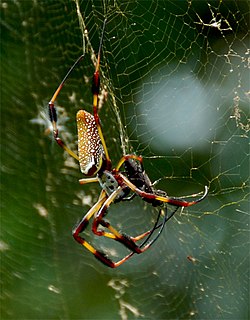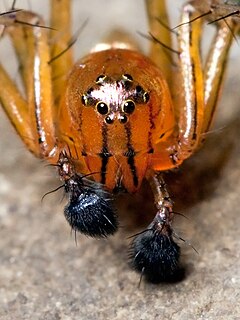
The subphylum Chelicerata constitutes one of the major subdivisions of the phylum Arthropoda. It contains the sea spiders, horseshoe crabs, and arachnids, as well as a number of extinct lineages, such as the eurypterids and chasmataspidids.

Arachnida is a class of joint-legged invertebrate animals (arthropods), in the subphylum Chelicerata. Arachnida includes, among others, spiders, scorpions, ticks, mites, pseudoscorpions, harvestmen, camel spiders, whip spiders and vinegaroons.

Schizomida is an order of arachnids, generally less than 5 millimetres (0.20 in) in length.

Thelyphonida is an arachnid order comprising invertebrates commonly known as whip scorpions or vinegaroons. They are often called uropygids in the scientific community based on an alternative name for the order, Uropygi. The name "whip scorpion" refers to their resemblance to true scorpions and possession of a whiplike tail, and "vinegaroon" refers to their ability when attacked to discharge an offensive, vinegar-smelling liquid, which contains acetic acid.

A book lung is a type of respiration organ used for atmospheric gas exchange that is present in many arachnids, such as scorpions and spiders. Each of these organs is located inside an open ventral abdominal, air-filled cavity (atrium) and connects with the surroundings through a small opening for the purpose of respiration.

Hemolymph, or haemolymph, is a fluid, analogous to the blood in vertebrates, that circulates in the interior of the arthropod (invertebrate) body, remaining in direct contact with the animal's tissues. It is composed of a fluid plasma in which hemolymph cells called hemocytes are suspended. In addition to hemocytes, the plasma also contains many chemicals. It is the major tissue type of the open circulatory system characteristic of arthropods. In addition, some non-arthropods such as molluscs possess a hemolymphatic circulatory system.

Arachnology is the scientific study of arachnids, which comprise spiders and related invertebrates such as scorpions, pseudoscorpions, and harvestmen. Those who study spiders and other arachnids are arachnologists. More narrowly, the study of spiders alone is known as araneology.

Pedipalps are the second pair of appendages of chelicerates – a group of arthropods including spiders, scorpions, horseshoe crabs, and sea spiders. The pedipalps are lateral to the chelicerae ("jaws") and anterior to the first pair of walking legs.

A carapace is a dorsal (upper) section of the exoskeleton or shell in a number of animal groups, including arthropods, such as crustaceans and arachnids, as well as vertebrates, such as turtles and tortoises. In turtles and tortoises, the underside is called the plastron.

The cephalothorax, also called prosoma in some groups, is a tagma of various arthropods, comprising the head and the thorax fused together, as distinct from the abdomen behind. The word cephalothorax is derived from the Greek words for head and thorax. This fusion of the head and thorax is seen in chelicerates and crustaceans; in other groups, such as the Hexapoda, the head remains free of the thorax. In horseshoe crabs and many crustaceans, a hard shell called the carapace covers the cephalothorax.
Quetzal is a group of colourful birds of the trogon family found in the Americas.
George Charles Champion was an English entomologist specialising in the study of beetles. He was born in Walworth, South London, and the eldest son of George Champion.

Guatemala, officially the Republic of Guatemala, is a country in Central America. Guatemala is bordered to the north and west by Mexico; to the northeast by Belize and the Caribbean; to the east by Honduras; to the southeast by El Salvador and to the south by the Pacific Ocean, respectively. With an estimated population of around 17.6 million, it is the most populous country in Central America and is the 11th most populous country in the Americas. Guatemala is a representative democracy; its capital and largest city is Nueva Guatemala de la Asunción, also known as Guatemala City, the largest city in Central America.
The slit sensilla, also known as the slit sense organ, is a small mechanoreceptory organ or group of organs in the exoskeleton of arachnids which detects physical deformation or strain due to forces experienced by the animal. The organ appears in the vast majority of discovered arachnids, and is "remarkably consistent" in location and direction within each order. The arachnid slit sensilla corresponds to the campaniform sensilla found in insects.

Zygoballus rufipes, commonly called the hammerjawed jumper, is a species of jumping spider which occurs in the United States, Canada, and Central America. Adult females are 4.3 to 6 mm in body length, while males are 3 to 4 mm.
Ludovico di Caporiacco was an Italian arachnologist.
Pseudocellus cookei is an arachnid species in the order Ricinulei. It occurs only in the cueva Jobitzinaj in Petén, Guatemala.
Vindullus is a genus of huntsman spiders that was first described by Eugène Louis Simon in 1880. Though often considered a synonym of Olios, it has been validated as its own genus.

"Arachnids in the UK" is the fourth episode of the eleventh series of the British science fiction television programme Doctor Who. It was written by showrunner and executive producer Chris Chibnall, directed by Sallie Aprahamian, and first broadcast on BBC One on 28 October 2018.












